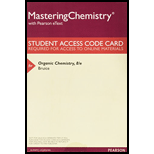
Organic Chemistry - MasteringChemistry
8th Edition
ISBN: 9780134074665
Author: Bruice
Publisher: PEARSON
expand_more
expand_more
format_list_bulleted
Question
Chapter 7.10, Problem 23P
Interpretation Introduction
Interpretation:
The value of
Concept Introduction:
In a reaction which strongly favours the formation of products, the base used to remove proton from the acid should be stronger than the base formed when the proton is removed.
Order of electronegativity of carbon atoms:
Most electronegative is the
The most acidic compound will be the hydrogen which is attached to the most electronegative carbon.
Expert Solution & Answer
Want to see the full answer?
Check out a sample textbook solution
Students have asked these similar questions
The pKa of our product is ~ 2-3 units lower than the pKa of phenol. Draw all possible resonance structures of the conjugate base of the product, and use these to explain why our product is so much more acidic than phenol.
which acid of each pair would you expect to be stronger?
then, provide a reaction of the selected stronger acid forming a carboxylate ion
help pls i will upvote
#2
In benzoic acid, when it has a deactivating group in position "para" (relative to carboxylate position) , it attracts electrons towards it, weakening the acid and an activator pushes the electrons making the acid stronger.What happens to this benzoic acid if it has a substituent at the "meta" or "ortho" position as an activator or a deactivator?
I need an explanation of what happens in each case please
Chapter 7 Solutions
Organic Chemistry - MasteringChemistry
Ch. 7.1 - Prob. 1PCh. 7.1 - Name the following:Ch. 7.1 - What is the molecular formula for a monocyclic...Ch. 7.1 - Draw the condensed and skeletal structures for...Ch. 7.1 - Draw the structure and give the common and...Ch. 7.2 - Prob. 6PCh. 7.2 - Name the following:Ch. 7.3 - What orbitals are used to form the carbon-carbon ...Ch. 7.4 - Prob. 9PCh. 7.4 - Why does cis-2-butene have a higher boiling point...
Ch. 7.6 - Prob. 12PCh. 7.6 - Prob. 13PCh. 7.7 - Prob. 14PCh. 7.7 - Which alkyne should be used for the synthesis of...Ch. 7.7 - Prob. 16PCh. 7.8 - Prob. 17PCh. 7.8 - Only one alkyne forms an aldehyde when it...Ch. 7.9 - Describe the alkyne you should start with and the...Ch. 7.9 - Prob. 20PCh. 7.10 - Prob. 21PCh. 7.10 - Prob. 22PCh. 7.10 - Prob. 23PCh. 7.10 - Rank the following from strongest base to weakest...Ch. 7.10 - Prob. 26PCh. 7.12 - Prob. 28PCh. 7 - What is the major product obtained from the...Ch. 7 - Draw a condensed structure for each of the...Ch. 7 - A student was given the structural formula of...Ch. 7 - Prob. 32PCh. 7 - What is each compounds systematic name?Ch. 7 - What reagents should be used to carry out the...Ch. 7 - Prob. 35PCh. 7 - Draw the mechanism for the following reaction:Ch. 7 - Prob. 37PCh. 7 - Prob. 38PCh. 7 - What is the major product of the reaction of 1 mol...Ch. 7 - Answer Problem 39, parts a-b, using 2-butyne as...Ch. 7 - What is each compounds systematic name? a....Ch. 7 - What is the molecular formula of a hydrocarbon...Ch. 7 - a. Starting with 3-methyl 1-butyne, how can you...Ch. 7 - Prob. 44PCh. 7 - Which of the following pairs are keto-enol...Ch. 7 - Prob. 46PCh. 7 - Do the equilibria of the following acid-base...Ch. 7 - What is each compounds systematic name?Ch. 7 - What stereoisomers are obtained when 2-butyne...Ch. 7 - Prob. 50PCh. 7 - Draw the keto tautomer for each of the following:Ch. 7 - Show how each of the following compounds can be...Ch. 7 - A chemist is planning to synthesize 3-octyne by...Ch. 7 - Prob. 54PCh. 7 - What stereoisomers are obtained from the following...Ch. 7 - Prob. 56PCh. 7 - Prob. 57PCh. 7 - Prob. 58PCh. 7 - Show how the following compound can be prepared...Ch. 7 - Prob. 60P
Knowledge Booster
Similar questions
- Treatment of indene with NaNH2 forms its conjugate base in a Brønsted– Lowry acid–base reaction. Draw all reasonable resonance structures for indene's conjugate base, and explain why the pKa of indene is lower than the pKa of most hydrocarbons.arrow_forwardTreatment of indene with NaNH2 forms its conjugate base in a Brønsted–Lowry acid–base reaction. Draw all reasonable resonance structures for indene’s conjugate base, and explain why the pKa of indene is lower than the pKa of most hydrocarbons.arrow_forwardWhich of the following substituent is an ortho/para-directing deactivator? a amino group b halogen group c phenyl group d carboxyl grouparrow_forward
- In Image 4 predict the effect the substituent attached to the benzene ring would have on electrophilic aromatic substitution reactions? a.ortho/para director, deactivator b.ortho/para director, activator c.meta director, activator d.meta director, deactivatorarrow_forwardHow do these mechanisms with NET3 work? Would someone be able to draw out the mechanisms? Specifically for the last one, I am confused because if NET3 is a base, shouldn't the double bond be the adjacent one (tetra substituted)?arrow_forwardNot sure how to approach this problem.arrow_forward
- Base from the illustration: 1. Which compound/s will test positive in Baeyer’s test? 2. Which compound/s will produce an orange precipitate upon reaction with 2,4-DNPH? 3. Which compound/s will test positive in the Iodoform test? 4. Which compound/s will produce a brick-red precipitate upon reaction with Fehling’s reagent (CuSO4, tartrate, NaOH)? 5.arrow_forwardAlcohols react with sulfonyl chlorides to form sulfonate esters. Only the O-H bond of the alcohol is broken in the reaction, and so no inversion of configuration occurs. The resulting sulfonate esters are reactive in SN1 and SN2 reactions since the sulfonate group is a very weak base and is therefore a good leaving group.Draw curved arrows to show the movement of electrons in this step of the mechanism.arrow_forward
arrow_back_ios
arrow_forward_ios
Recommended textbooks for you
 Organic Chemistry: A Guided InquiryChemistryISBN:9780618974122Author:Andrei StraumanisPublisher:Cengage Learning
Organic Chemistry: A Guided InquiryChemistryISBN:9780618974122Author:Andrei StraumanisPublisher:Cengage Learning

Organic Chemistry: A Guided Inquiry
Chemistry
ISBN:9780618974122
Author:Andrei Straumanis
Publisher:Cengage Learning